 The trees of The Queen's Copse & The Platinum Copse
The trees of The Queen's Copse & The Platinum Copse
The Queen's Copse and The Platinum Copse within Abbey Meadows, Titchfield, are specially created to offer secluded and protected wildlife habitats to encourage biodiversity in the area. Fareham residents, groups, organisations, clubs and businesses were able to sponsor trees either for themselves or in memory of a loved one. Applications for tree sponsorship are now closed.
Here you'll find information about each of the trees that have been sponsored, including their uses and the customs and legends that have grown around them.
- Pedunculate/English Oak
- Hazel
- Wild Cherry
- Sweet Chestnut
- Aspen
- Hornbeam
- Field Maple
- Hawthorn
- Small-leaved Lime
- Crab Apple
Pedunculate/English Oak (Quercus robur)
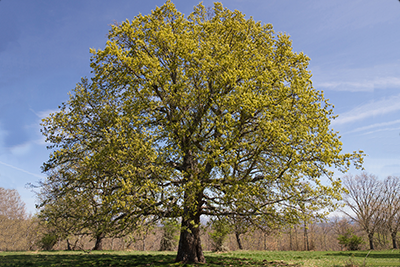 Native to Britain, the English oak is known as the common or pedunculate oak and is a tree capable of great longevity and imposing stature, reaching a height of 33 metres. The oak can live to well over 700 years, second only to the yew in Britain. England was at one time covered in oak woodland; by the reign of Henry VIII one third of the land was still dominated by oak, but this has gradually declined over the centuries, mostly at the hand of humans.
Native to Britain, the English oak is known as the common or pedunculate oak and is a tree capable of great longevity and imposing stature, reaching a height of 33 metres. The oak can live to well over 700 years, second only to the yew in Britain. England was at one time covered in oak woodland; by the reign of Henry VIII one third of the land was still dominated by oak, but this has gradually declined over the centuries, mostly at the hand of humans.
Uses
After a century oaks begin to mature. Virtually indestructible, the close-grained wood lasts for centuries and was used for bridge piles. The Vikings made their longboats from European oaks and they have been used in naval ship building as far back as Roman times. So many oak trees were felled for timber in England that Nelson asked the Crown to replant new oak trees. Oak bark is called 'tanner's bark' because of its worldwide use in tanning leather.
Custom and legend
The oak is host to many different species and is referred to as 'garden and a country'. It has long been regarded as an emblem of hospitality and strength to humans. The oak is possibly the most widely revered of all trees, considered sacred to many civilisations and cultures throughout history, and in Britain still stands proud as the 'Father of Trees'.
Hazel (Corylus avellana)
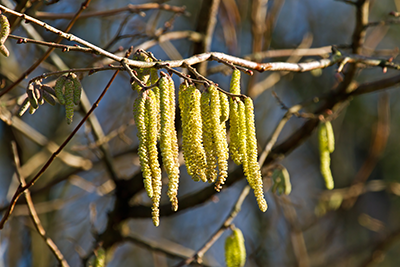
Hazel is common throughout most of Britain and can grow to the size of a small tree, but is often a large shrub with many stems. The hazelnuts ripen in September and provide food for many small animals such as dormice, squirrels and several common birds.
Uses
Hazel provides many small timber products used by 'countryfolk', such as beaters for pheasant rousing, support for crops such as beans and peas, thatcher's 'springels' for holding that in place and hedge stakes to name a few. Hazel can be coppiced, following which it produces long straight stems from ground level. The new growth is flexible and difficult to break and is used in basket making, for hoops and hurdles, fishing rods and walking sticks.
Custom and legend
The hazel was historically regarded as the Celtic tree of knowledge and the nuts were believed to be the ultimate receptacles of wisdom. The shoots and twigs of hazel have the power to reveal the presence of water and have been used throughout history for dowsing. In Anglo-Saxon times swineherds used hazel rods to control their animals.
Wild Cherry (Prunus avium)
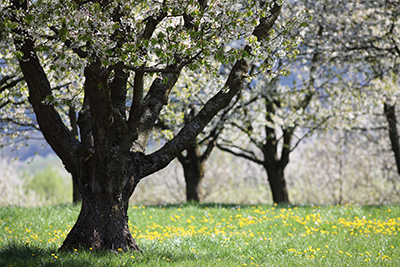
The wild cherry is one of the smaller native British trees. Individual trees are often found growing in broadleaved lowland woods. In spring, one of the first signs of life is the white blossom of the wild cherry, which hangs in heavy clusters and clearly shows off the tree. The fruits known as cherries are edible but are often bitter to the taste and not as fleshy or sweet as cultivated varieties.
Uses
The wood is often used as a veneer on pieces of furniture as it is a strong hardwood that can be polished to a shiny, attractive brown finish.
Custom and legend
The wild cherry is thought to have had enigmatic qualities according to Highland folklore and, in those days, to come across a wild cherry tree was considered fortunate. Wild cherry folklore is also associated with the cuckoo. In Scotland, the wild cherry is known as 'gean'. This is thought to have been derived from 'guigne', a French word for cherry. The resin that leaks from the trunk was recorded as a cough treatment and was often dissolved in wine to treat gall stones and kidney stones.
Sweet Chestnut (Castanea sativa)
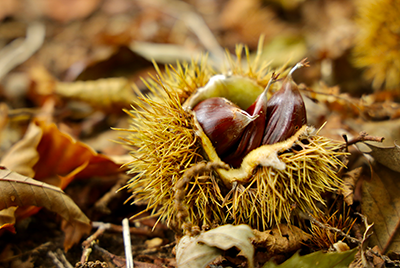
The sweet chestnut was introduced to Britain by the Romans from southern Europe and can live for 1000 years. In medieval times, it was valued for its nuts, and plantations were established. There was a chestnut wood in the Forest of Dean, Gloucestershire in 1170. Sweet chestnut is a very distinctive tree, with large leaves resembling spear blades with saw-tooth edges. The famous fruit develops inside a four-lobed spiny case, which falls in the autumn, splits open and reveals three nuts. Mature sweet chestnuts have very unusual bark; on young trees, it is smooth and brown, but rapidly becomes deeply fissured and spiral around the main trunk.
Uses
Sweet chestnut timber is similar to oak but is more lightweight and easier to work. The 'poles' which grow after coppicing are used in chestnut paling fences, which are still commonly used. In 1956 there were 5000 acres of chestnut coppice in Kent, Surrey, Sussex and Hampshire. Longer poles are used to support frames up which hops are grown in Kent. The seeds of the sweet chestnut are roasted and famously sold on street corners at Christmas.
Custom and legend
The botanical name of the sweet chestnut, 'castanea', comes from Castanis, an ancient city located in present-day Turkey. Originally from Asia Minor, this fruit tree was introduced into the Cévennes region in France by the Romans.
Aspen (Populus tremula)
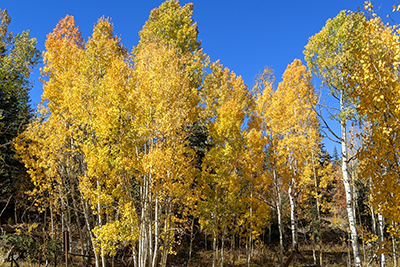 Aspen are observed hardly ever to be still; their leaves tremble in the slightest breath of wind. The leaf stalks (petioles) are flattened at right angles to the leaf blade, which causes incessant movement. They do not like shade and grow in open areas, in damp ground, on heathland and at higher elevations on mountains. Cattle, goats and deer like to feed on aspen and can strip young trees of foliage and bark. In autumn, trees turn from green to beautiful golden yellow foliage, which shimmers in the low sun. The species is relatively short-lived, reaching 50 to 60 years old.
Aspen are observed hardly ever to be still; their leaves tremble in the slightest breath of wind. The leaf stalks (petioles) are flattened at right angles to the leaf blade, which causes incessant movement. They do not like shade and grow in open areas, in damp ground, on heathland and at higher elevations on mountains. Cattle, goats and deer like to feed on aspen and can strip young trees of foliage and bark. In autumn, trees turn from green to beautiful golden yellow foliage, which shimmers in the low sun. The species is relatively short-lived, reaching 50 to 60 years old.
Uses
Poplar timber has little value as it is not very durable. Aspen wood is very soft, beautifully white and ideal for carving and sculpting. Poplar wood is very buoyant and was made into oars and paddles. The Greek for aspen is aspis, which means shield, and poplar wood is known to have been used for shields by the Celts, who deemed the art of shield-making to be sacred.
Custom and legend
Aspen is known as the trembling, shaking or quivering tree because of the continuous movement in the slightest breeze, and the whispering tree due to its rustling leaves. Golden aspen leaves have been found in burial mounds in Mesopotamia dating from 3000 BC. In legend, poplar leaves were worn by heroes and it is said this allowed them to visit the Underworld and return.
Hornbeam (Carpinus betulus)
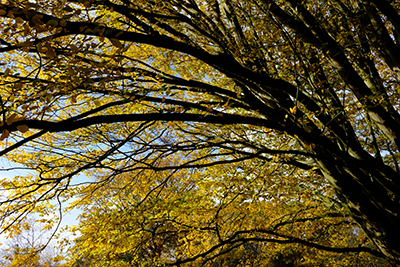 The common English name hornbeam derives from the hardness of the wood, likened to horn and the Old English beam "tree" (as with the Dutch ''Boom'' and German Baum). The hornbeam is a medium size to large tree, capable of reaching a height of 32 metres. Hornbeams are used as food plants by the larvae of some Lepidoptera species, including autumnal moth, common emerald, feathered thorn, walnut sphinx, Svensson's copper underwing, and winter moth.
The common English name hornbeam derives from the hardness of the wood, likened to horn and the Old English beam "tree" (as with the Dutch ''Boom'' and German Baum). The hornbeam is a medium size to large tree, capable of reaching a height of 32 metres. Hornbeams are used as food plants by the larvae of some Lepidoptera species, including autumnal moth, common emerald, feathered thorn, walnut sphinx, Svensson's copper underwing, and winter moth.
Uses
Hornbeams yield a very hard wood, giving rise to the name 'ironwood'. The dried heartwood is nearly white and is suitable for decorative use. The wood is used to construct carving boards, tool handles, coach wheels, piano hammers, shoe lasts and other products where a very tough, hard wood is required. The wood can also be used as gear pegs in simple machines, including traditional windmills, and is also used in parquet flooring and for making chess pieces.
Custom and legend
Romans used hornbeam to make their chariots because of the strength of the wood. People born in June are said to have fallen from the Hornbeam tree. Hampton Court's Maze in London was originally made of hornbeam before being replaced with yew and holly. In London, the tree was harvested for charcoal.
Field Maple (Acer campestre)
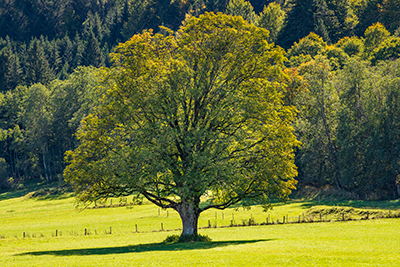
Field maple is a small tree native to Britain and is most often found in hedgerows and on the edge of woods. Its distribution is on limestone chalk or other calcareous soils, but is widely planted as an amenity tree. The bark is rough, brown and usually corky when older. Field maple is unusual in that its outer branches often become ridged as well as the main trunk. The leaves are small (half the size of sycamore) with 5 blunt lobes and they turn to a golden yellow in autumn.
Uses
Before the arrival of the sycamore, field maple wood was prized for carved work such as bowls. Field maple is a tough tree, tolerant of pollution and, with many compact modern cultivars, makes an excellent urban tree for streets and gardens. The tree is attractive to aphids and their predators, including many species of ladybird, hoverfly and bird. The flowers provide nectar and pollen for bees and birds, and small mammals eat the fruits.
Custom and legend
Field maple appears very little in our history having been mainly used as a hedging tree. A glimpse of this appears in a charter of 901 AD for Hurstborne Priors in Hampshire. Occasionally, old pollarded maples can be seen, such as at Hatfield Forest in Hertfordshire. In parts of Europe, it was thought that maple branches hung around doorways would stop bats entering. The herbalist Culpepper recommended maple leaves and bark to strengthen the liver.
Hawthorn (Crataegus monogyna)
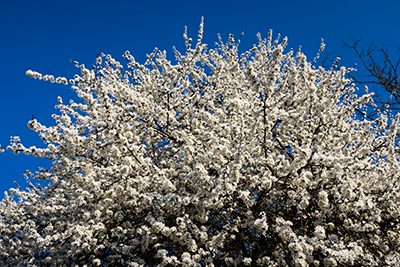 Hawthorn is a small tree growing up to 9 metres and is often broader than it is high. Generally considered to be a hedgerow tree, 'haw' is believed to mean hedge. Hawthorn is more a village tree than a forest tree and seems to prefer growing where land is managed by people. It provides food and shelter for many small birds, mammals and more than 50 insect species.
Hawthorn is a small tree growing up to 9 metres and is often broader than it is high. Generally considered to be a hedgerow tree, 'haw' is believed to mean hedge. Hawthorn is more a village tree than a forest tree and seems to prefer growing where land is managed by people. It provides food and shelter for many small birds, mammals and more than 50 insect species.
Uses
Hawthorn wood is tough and durable but, as the tree is relatively small, it only provides enough wood to make small things, such as handles, particularly the handles of personal items such as knives and daggers, because the wood is considered lucky. The wood is the best for burning, more so than oak; it burns hot and makes excellent charcoal. Hawthorn berries can be made into jellies, wines and even chutneys. The hawthorn is an important hedging plant. It is fast growing when young and forms a dense impenetrable barrier to livestock. Having hawthorn in fields was known to make cattle thrive.
Custom and legend
Hawthorn is the most deeply enshrined tree in the traditions and folk law of the English countryside. Poets like Chaucer have sung the hawthorn's praises throughout the centuries. In pagan nature worship, it is a symbol of fertility and was the traditional tree used at marriages. In ancient times, hawthorn cults were ruled by goddesses who deemed the tree to be sacred.
Small-leaved Lime (Tilia cordata)
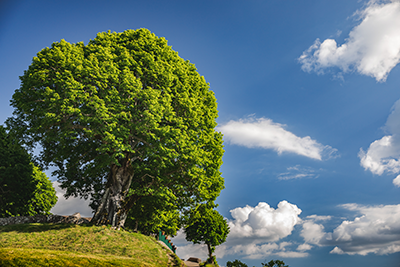 Small-leaved lime is native to much of Europe and Britain. It grows best on moist but well-drained nutrient-rich soils and was once a dominant woodland species. It is now rare in woods and, in some English regions, it is considered an indicator species of ancient woodland. Lime leaves are eaten by the caterpillars of many moth species and they are very attractive to aphids, providing a source of food for their predators, including hoverflies, ladybirds and many species of bird. The flowers provide nectar and pollen for insects, particularly bees, which also drink aphid honeydew from lime leaves.
Small-leaved lime is native to much of Europe and Britain. It grows best on moist but well-drained nutrient-rich soils and was once a dominant woodland species. It is now rare in woods and, in some English regions, it is considered an indicator species of ancient woodland. Lime leaves are eaten by the caterpillars of many moth species and they are very attractive to aphids, providing a source of food for their predators, including hoverflies, ladybirds and many species of bird. The flowers provide nectar and pollen for insects, particularly bees, which also drink aphid honeydew from lime leaves.
Uses
Lime wood is soft and light, white-yellow and finely textured. It is easy to work and used in turnery, carving and furniture-making. The wood is still used today to make sounding boards and piano keys as it doesn't warp. The flowers were used to make tea, especially during the Second World War when leaf tea was hard to come by. The tree's sweet sap was made into wine. The flowers were valued for their medicinal properties and they were considered an effective treatment for insomnia, headaches and other 'nervous' disorders. Lime bark was traditionally used to make rope - almost certainly lime bast rope was used to drag the large rocks from South Wales to Salisbury Plain in the construction of Stonehenge.
Custom and legend
Limes appear in folklore across Europe. They are often associated with fertility, especially in Estonia and Lithuania. It's also considered a sacred tree in Slavic mythology and German folklore where it represented fairness and justice. Lime has been associated with romance and used as a symbol in romantic poetry. In France and Switzerland, limes represent liberty, and the trees were planted to celebrate different battles. It was also said that sitting under a lime tree would cure epilepsy.
Crab Apple (Malus sylvestris)
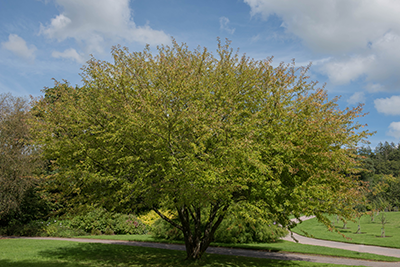
The crab apple is Britain's only native apple tree. In ancient times, there were 22 different types of apple recorded and it wasn't until the eighteenth century that hybrids appeared in Britain from Europe, particularly France. Different species were grafted onto wild apple trees to produce a better yield. There are now about 2000 different species of apple worldwide.
Uses
The most obvious and well known use of the apple is its fruit - a rich source of health-giving food and drink for humans, excellent for healing both the mind and body. Apple wood has a beautiful grain and often carved into small items and gifts. Cider apples were the traditional mainstay of farming communities; the cider produced on farms refreshed farm workers and was a health-giving commodity. At Yule festivities, a wassailing bowl full of roast apples was said to give a party good cheer.
Custom and legend
The apple is a very important tree in Celtic legend and further back in Greek legend. In Greek myths, the apple orchards of Paradise were known as the Garden of the Hesperides, where there grew a very sacred apple tree whose fruit were said to confer immortality. The apple has long been symbolic of the giving of love and in Celtic times apples were considered food of the gods.
